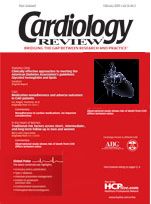Chest pain relief from nitroglycerin: Very little comfort
Nitroglycerin was one of the first medicines used for the treatment of angina pectoris. Murrell noted in 1879 that administration of the drug would provide quick, if fleeting, relief from chest pain.1 Since then this relief has been used as a tool to predict the likelihood of obstructive coronary disease. The Diamond and Forrester criteria go so far as to include it as one criterion to define typical angina pectoris.2 The mechanism of this relief, however, is multifactorial. Nitroglycerin acts on vascular smooth muscle cells to stimulate an increase in cyclic guanine monophosphate, which results in a dilation of veins, arteries, and coronary arteries. The relief of chest pain, however, is not likely to be the result of an increased blood flow through obstructed coronary arteries. Instead, in the acute setting, nitroglycerin via systemic vasodilation is thought to decrease preload, thus decreasing myocardial work and oxygen demand.
Henrikson and Chandra-Strobos (page 22) investigated the validity of chest pain relief from nitroglycerin as having predictive or prognostic value in active coronary artery disease (CAD).3 They prospectively evaluated 459 patients who had chest pain and received nitroglycerin. These patients were then classified as being “nitroglycerin-responsive” if they had a greater than 50% reduction in pain (subjective scale) and were simultaneously designated as having “active CAD” or “no active CAD” on the basis of appropriate symptoms with at least one of the following: elevated troponin T, coronary angiography with 70% or greater stenosis, a positive exercise stress test with or without imaging, or a clinical diagnosis made by typical symptoms in the setting of known severe disease. To be classified as no active CAD, patients also had to be free of cardiovascular events in the follow-up period of 4 months. The sensitivity of response to nitroglycerin in evaluating for CAD was 35% while the specificity was 59%. Changing the definition of responsiveness from 50% to other percent reductions or by an absolute reduction on a pain scale did not increase the predictive power of nitroglycerin responsiveness. They also noted that there were no significant outcome differences between the nitroglycerin responsive and unresponsive groups.
The authors acknowledged that the study was limited by the subjective nature of the pain rating scales. Also, the study did not standardize the workups of the patients once they were admitted to the hospital. The hazard is that those patients who responded to nitroglycerin were then more extensively evaluated for CAD. This investigation was conducted in the acute setting and on patients with acute chest pain; thus, extreme caution must be used in extrapolating these findings to patients with chronic chest pain in an outpatient setting. It would be dangerous, based on these findings, to dismiss an escalation of chest pain that is relieved by nitrates in a patient with known CAD.
This study highlights the complex nature of evaluating chest pain. Pathology, symptoms, and therapeutics do not follow a simple formula, and the findings clearly support the idea that pain relief from nitroglycerin does not have a significant role in establishing an acute diagnosis. However, it would also be imprudent to totally dismiss the use of nitroglycerin in the acute setting. While a physician may not be comforted by the response (or lack thereof) to nitroglycerin, alleviating a patient’s discomfort without detriment remains a worthwhile goal.
